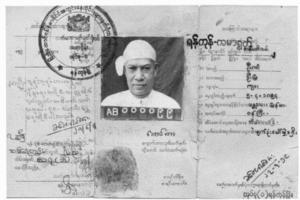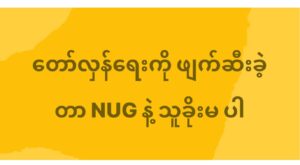By U Aung Tin shared Okkar Shwe Min post | Translation & Editorial by MMNN
Part 1 – The Bitter Prediction
After General Aung San’s assassination, The London Times published an article on July 20, 1947, based on an interview with Dr. Ba Maw. In it, he said:
“Burmese youth have now tasted the power of armed struggle. In the future, politics in Burma will not be decided by ballots—but by bullets.”
That chilling prophecy would prove to be heartbreakingly accurate. As we reflect today on our nation’s history, we realize we’ve been hemorrhaging blood, not casting votes.
Even before independence was fully achieved, ethnic armed rebellions had begun:
- Mon began their uprising on 20 July 1948, under the MNDO banner.
- Karenni rose on 17 August 1948.
- Karen launched armed struggle on 31 January 1949.
- Pao joined on 11 December 1949.
- Shan began their resistance on 21 May 1958.
- Kachin, under KIO, started in 1961 over religious discontent.
- Palaung formed the PNF on 12 January 1963.
- Kayah rose on 4 June 1964.
- Rakhine began even earlier, in 1946, and formed the ALP by 1967.
These were just the post-independence insurgencies. They don’t even include the newer waves of rebellion that continue to this day. In Miyanmar, it seems every enlightened person becomes a rebel eventually.
Part 2 – The Communist Fracturing
It wasn’t just the ethnic groups who took up arms.
The first to light the revolutionary torch were the Communists.
Just ten days after the Pyinmana Conference, on 28 March 1948, the Burma Communist Party (BCP) went underground and began armed resistance. That marked the start of our internal civil war.
Even among Communists, unity was short-lived. They soon splintered:
- The Red Flag faction led by Thakin Soe
- The White Flag faction led by Thakin Than Tun
Even non-armed Communists began to split up further:
- U Thein Pe Myint’s above-ground faction
- Ethnic-based and ideology-based variants
Eventually, we ended up with:
- Socialist-leaning Communists
- Blue-flag Socialists
- Exotic, green-tinged Communists
Every possible flavor of leftist politics—each one claiming moral superiority over the rest.
Part 3 – The Ideological Madness
The disintegration didn’t stop with politics. It metastasized ideologically.
Communist factions began aligning themselves with foreign figureheads:
- Stalinist Line
- Maoist Line
- Khrushchev Line
- Brezhnev Line
- Titoist Line
- Ho Chi Minh Line
These were distant foreign leaders, whom most ordinary Burmese had never seen or heard speak, yet their names became sacred divisions.
Even within jungle-based CPB factions, splits like the “55-mile line” and “64-mile line” appeared. That’s how fractured things became.
As for the Socialists?
- Left-wing Socialists split into 9 factions
- Right-wing Socialists broke into 2 groups
- The “Myanmar Way” Socialists fractured into 2 more
Then, the ruling BSPP itself couldn’t escape.
Even they split into:
- Soe Nyunt’s “Peace and Reconciliation” group
- Nu Tin’s “Purity” faction
When even the governing party fractures, it’s no longer a political problem—it’s a national breakdown.
Worst of all, this toxic political virus eventually spread into the military itself.
Part 4 – Of Graves and Grudges
Even within the powerful Tatmadaw, with a force of hundreds of thousands…
…nearly one-third have defected or rebelled at some point.
Meanwhile, the only organization that has stayed united in over a century?
The Funeral Donation Association.
And that’s likely because they handle religious rituals, not guns or power.
At the root of this constant fracturing is a deep psychological defect:
Once a group gains momentum, they declare:
“We alone are right. We are pure. Everyone else is misguided.”
They judge. They condemn. They excommunicate.
And of course, blind followers cheer and repeat like parrots.
But worse still:
- Old grudges
- Bitterness from the past
- The flames of ego
…are passed down as inheritance to the next generation.
Children and disciples carry forward these unresolved hatreds.
And so, even when people die, their problems never do.
Old wounds are reopened. Historical markers are weaponized.
It continues to this very day.
So much so that Myanmar has become a land of blood ledgers, where debts are settled with bullets, not ballots.
The Buddha once warned:
“Hatred never ceases by hatred. Hatred ceases only by love. This is the eternal law.”
In modern terms? That’s called non-zero-sum thinking.
It’s time to look beyond personal pain, beyond tribal identity, and ask:
What’s best for the country?
Let’s stop carrying the rotting remains of our past.
Let’s bring forward only what’s noble and unifying.
Final Reflection – Who Among Us Is Without Sin?
By Okkar Shwe Min (shared by U Aung Tin)
One group blames the other:
“Because of you.”
“No, because of you.”
And on and on.
Once, a crowd tried to stone a “sinner” with rocks and rotten eggs.
Jesus stepped in and said:
“Let the one who is without sin cast the first stone.”
Everyone paused. Reflected. And quietly walked away.
Because—who is truly innocent?
Meanwhile, the world has moved on:
- Israel stands firm among its neighbors
- Japan has risen from atomic ashes
- Singapore, once water-scarce, became a global leader
- Vietnam, bombed to dust, now holds its head high
- China, once boiling rice with garlic and salt, became an economic titan
- India, despite its vast religious diversity, remains stable
- European nations, once war-torn, now collaborate with giants like the U.S., U.K., France, and Germany
So who’s left behind?
Only us.
Still stuck. Still pointing fingers.
Still bleeding from the past.
Let us not return to the Stone Age.
Let us finally move forward—together.
ကျောက်ခေတ်သွားမည် မီယမ်မာပြည်
ဗိုလ်ချုပ်အောင်ဆန်းတို့ လုပ်ကြံခံရအပြီး နောက်တစ်ရက်မှာ ထုတ်တဲ့ ၁၉၄၇ ဇူလိုင်၂၀ရက်နေ့ လန်ဒန်တိုင်းမ်သတင်းစာက ဒေါက်တာဘမော်ကို အင်တာဗျူးပြီး ဆောင်းပါးတစ်ခုရေးတယ်။
အဲဒီဆောင်းပါးထဲမှာ ဒေါက်တာဘမော်က
“မြန်မာလူငယ်တွေဟာ လက်နက်ကိုင်ခြင်းရဲ့အရသာကို သိသွားခဲ့ပြီ၊ ဒါကြောင့် နောင်အခါ မြန်မာ့နိုင်ငံရေးကို အဆုံးအဖြတ်ပေးမှာက မဲပုံးတွေမဟုတ်ပဲ လက်နက်တွေပဲ ဖြစ်နေလိမ့်မယ်”လို့ ဖြေခဲ့သတဲ့။
အဲဒီစကားဟာ အတိတ်ကို ပြန်တူးဆွကြည့်ရင်း သမိုင်းနဲ့အတူ မှတ်ကျောက်တင် စောကြောကြည့်လိုက်တဲ့အခါမှာ သွေးထွက်အောင်မှန်လှချည်လား လို့ ထုပ်ထုပ်ပိုက်ပိုက်ကြီးတွေးမိလေရဲ့။
စလယ်၀င် ဖင်မမည်းခင်ကတည်းက ကွဲခဲ့ကြတာမို့ .
သန္တေတည်စ လွတ်လပ်ရေးလေးကို လက်နက်ကိုင်ဓလေ့တွေက အတင်းအဓမ္မဖျက်ချခဲ့ကြတယ်လို့ ဆိုရမယ်။
လူမျိုးစုအခွင့်အရေးလို့ ကြွေးကြော်ပြီး အမျိုးစုံသော တိုင်ရင်းသားတွေက ကိုယ်စီစစ်တပ်တွေဖွဲ့စည်းပြီး လက်နက်ကိုင်ခဲ့ကြတယ်။
(က) မွန်တွေဟာ 1948 ခုနှစ် July လ 20 ရက်နေ့မှာပဲ MNDOဆိုတဲ့နာမည်နဲ့အတူ လက်နက်ကိုင်တော်လှန်ခဲ့ကြတယ်။
(ခ) ကရင်နီတွေဟာ 1948 ခုနှစ် August လ 17 ရက်နေ့မှာ လက်နက်ကိုင်တော်လှန်ခဲ့ကြတယ်။ (1957 ခုနှစ်မှာတော့ KNPPကို ဖွဲ့စည်းခဲ့တယ်။)
(ဂ) ကရင်တွေဟာ 1949 ခုနှစ် January လ 31 ရက်နေ့မှာ လက်နက်ကိုင်တော်လှန်ရေး စတင်ခဲ့ပါတယ်။
(ဃ) ပအိုဝ်တွေဟာ 1949 ခုနှစ် Decemberလ 11 ရက်နေ့မှာ တော်လှန်ရေး စတင်ခဲ့တယ်။
(င) ရှမ်းတွေဟာ 1958 ခုနှစ် May လ 21 ရက်နေ့ လက်နက်ကိုင်တော်လှန်ရေး စတင်ခဲ့တယ်။
(စ) ကချင်တွေဟာ 1961 ခုနှစ်မှာ KIO ကို ဖွဲ့စည်းပြီး ဘာသာရေးမကျေနပ်ချက်ကြောင့် လက်နက်ကိုင်တော်လှန်ရေးကို စတင်ခဲ့တယ်။
(ဆ) ပလောင်အမျိုးသားတွေဟာ 1963 ခုနှစ် January လ 12 ရက်နေ့မှာ ပလောင်အမျိုးသား လက်နက်ကိုင်တပ်ဖွဲ့ PNF ကို ဖွဲ့စည်းပြီး လက်နက်ကိုင်တော်လှန်ရေးကို တိုးမြှင့်ဆင်နွှဲခဲ့တယ်။
(ဇ) ကယန်းအမျိုးသားတွေဟာ 1964 ခုနှစ် June လ 4 ရက်နေ့မှာ လက်နက်ကိုင်တိုက်ပွဲကို ဆင်နွှဲခဲ့ကြတယ်။
(စျ) ရခိုင်အမျိုးသားတွေဟာ 1946 မှာ လက်နက်ကိုင်တော်လှန်ရေးကို စတင်ခဲ့ကြတယ်။ 1967 ခုနှစ်မှာ ALPကိုဖွဲ့ခဲ့ကြတယ်။
ဒါက လွတ်လပ်ရေးရပြီးစ တိုင်းရင်းသားလက်နက်ကိုင်မှုတွေ။ နောက်ခေတ်တွေ(ယနေ့အချိန်အထိ) လက်နက်ကိုင်နေတာတွေ မပါသေးဘူး။ ခေတ်မှီသူတိုင်း သူပုန်ထကြသည်လို့ ဆိုရမလိုလို။
တိုင်းရင်းသားတွေ လက်နက်ကိုင်ယုံတင်ပဲလားဆိုတော့ မဟုတ်သေးဘူး။
ဗမာများကလည်း အချင်းချင်း လက်နက်ကိုင်ချကြသေးသလို မြေပေါ်မှာကလည်း ကြက်ပျံ ငှက်ပျံမကျ စည်စည်ကားကားကြီး ကွဲတော်မူကြလေရဲ့။
လက်နက်ကိုင်တော်လှန်ရေးကို စျေးဦးဖောက်လိုက်သူတွေက ဗမာပြည်ကွန်မြူ နစ်ပါတီ(ဗကပ)ဖြစ်လေ၏။
ပျ ဉ်းမနားညီလာခံအပြီး ဆယ်ရက်အကြာ ၁၉၄၈ မတ်လ ၂၈ရက်မှာ တောခိုတယ်။
မြန်မာပြည် ပြည်တွင်းစစ်စတဲ့နေ့လို့ ဆိုရမှာပဲ။
အဲဒီကွန်မြူ နစ်တွေမှာကလည်း သခင်စိုးဦးဆောင်တဲ့အလံနီနဲ့ သခင်သန်းထွန်းဦးဆောင်တဲ့အလံဖြူ ဆိုပြီး လက်နက်ကိုင်ကွန်မြူ နစ်တွေချင်း နှစ်ပိုင်းကွဲပြဲတယ်။
လက်နက်မကိုင်ပဲ မြေပေါ်ကျန်ခဲ့တဲ့ ကွန်မြူ နစ်တွေကလည်း ထပ်ကွဲကြပြန်တယ်။
ဦးသိန်းဖေမြင့်တို့ရဲ့ မြေပေါ်ကွန်မြူ နစ်အဖွဲ့ကလည်း ရှိသေးတယ်။
တစ်ဖန် အမျိုးသားရေးကို အခြေခံတဲ့ ကွန်မြူ နစ်တွေကလည်း ရှိပြန်တယ်။
ရဲဘော်ဖြူ ထဲမှာတောင် ကွန်မြူနစ်က တစ်ဖွဲ့ခွဲထွက်လာပြန်တယ်။
ဆိုရှယ်နီ၊
အလံပြာ၊
ထူးစိမ်းကွန်မြူ နစ်ဆိုတာတွေကလည်း ရှိပြန်တယ်။
အဲလိုကွဲကြရတာတင် အားမရကြသေးလို့ .. သဘောတရားရေးရာအရ ထပ်ကွဲကြပြန်တယ်။
စတာလင်လိုင်း၊
မော်စီတုန်းလိုင်း၊
ခရုရှက်လိုင်း၊
ဘရက်ဇညက်လိုင်း၊
မာရှယ်တီးတိုးလိုင်း၊
ဟောက်ဇွာလိုင်းဆိုပြီး
နိုင်ငံခြားက ဘာကြီးတွေမှန်းမသိ၊
လူအရှင်လတ်လတ်လည်း မမြင်ဘူးကြတဲ့
ကမ္ဘာကျော်ကွန်မြူ နစ်များကို
ပုဂ္ဂိုလ်ရေးအရ အခြေပြုကိုးကွယ်ပြီး ကွဲကြပြန်တယ်။
တောခိုတဲ့ ဗကပတွေထဲမှာတောင် ၅၅လမ်းစဉ်နဲ့
၆၄လမ်းစဉ်ဆိုပြီး အချင်းချင်း ကပ်ကွဲလိုက်ကြသေးတာဗျာ။
အားရပါပေ့။
ဒါက ကွန်မြူ နစ်အကွဲအပြဲတွေ။ အားလုံးပေါင်း ကွန်မြူ နစ်တွေက (၉) ဖွဲ့ကွဲကြတယ်။
ကွန်မြူ နစ်တွေကွဲကြလို့ ..
ဆိုရှယ်လစ်တွေကရော
ဘယ်နှယ့်နေမလဲကြည့်ပြန်တော့
ပိုလို့တောင် ဆိုးနေပါကော။
ဆိုရှယ်လစ်က
အဓိကအားဖြင့် အဖွဲ့ကြီး ၃ဖွဲ့ကွဲတယ်လို့ ဆိုရမယ်။
လက်ဝဲဆိုရှယ်လစ်ရယ်၊
လက်ယာဆိုရှယ်လစ်ရယ်၊
မြန်မာ့နည်းမြန်မာ့ဟန်ဆိုတဲ့ ဆိုရှယ်လစ်ရယ်ပေါ့။
အဲဒီမေဂျာအဖွဲ့ကြီးတွေကနေ လက်ဝဲဆိုရှယ်လစ်တွေက ၉ဖွဲ့ကွဲ၊
လက်ယာဆိုရှယ်လစ်တွေက ၂ဖွဲ့ကွဲ၊
မြန်မာ့နည်းမြန်မာ့ဟန်မောင်များက ၂ဖွဲ့ကွဲ အသီးသီးကွဲကြလေ၏။
ကဲ .. တောခိုသူပုန်များ၊ အတိုက်အခံများကွဲကြလို့ အာဏာရတဲ့ ဖဆပလကရော ညီရဲ့လားဆိုတော့ .. ဟင့်အင်းပဲ။
ဖဆပလကလည်း
ဆွေငြိမ်းနဲ့ နုတင်ဆိုပြီး
တည်မြဲနဲ့သန့်ရှင်းကွဲကြလေကော။
သူပုန်တွေ၊ အတိုက်အခံတွေ ကွဲကြတာက ပြသနာသိပ်မရှိပေမယ့် အုပ်ချုပ်နေတဲ့ ပါတီက ကွဲကြတာဆိုတော့ တိုင်းပြည်ပျက်မတတ်ပါပဲ။
နောက်ဆုံး နိုင်ငံရေးအယူအဆ၊ အသင်းအဖွဲ့တွေတင် ကွဲလို့ အားမရကြပေတော့
စစ်တပ်ထဲကိုပါ နိုင်ငံရေးပိုးသွင်းကြလေတယ်။
အဲမှာ အင်အားကလေးမှ ထောင်ဂဏာန်းလောက်ရှိတဲ့ ဗမာ့စစ်တပ်မှာ
သုံးပုံ တပုံလောက်က တောခိုကောဗျာ။
အေးရော။
ကျုပ်တို့တိုင်းပြည်မှာ
အနှစ်၁၀၀ကျော်အောင်
ညီညွတ်တည်မြဲတဲ့အဖွဲ့အစည်းဆိုလို့
မလွန်ဆန်လှူ အသင်းပဲ ရှိတာဗျ။
မယုံရင် စုံစမ်းလေ့လာကြည့်။
အဲဒါလည်း အာဏာတွေ
သေနတ်တွေမပါတဲ့
ဘုရားရေး တရာရေးကိစ္စတွေ လုပ်ကြတဲ့အဖွဲ့မို့ အဲလောက်ခံနေတာ ထင်ပါတယ်။
အဲလိုတွေဖြစ်ကြတာကလည်း စိတ်အခံတွေက ဖောက်ပြန်ကြတာကိုး။
နေရာတစ်ခုကိုရောက်သွားရင် ငါတို့သာ အမှန်,မြင့်မြတ်တယ်။
သူတို့တစ်တွေလုပ်သမျှ က
မိစ္ဆာလုပ်ရပ်လို့ တစ်ဖက်သတ်စွဲချက်တင်ဆုံးဖြတ်လိုက်ကြကော။
မိုက်လုံးကြီးစရာ နောက်လိုက်နောက်ပါများကလည်း ရှိတာကိုး။
ပိုဆိုးစေတဲ့အချက်က
အတိတ်က ခါးသီးမှု
အာဃာတမီးတောက်တွေ
လက်ဆင့်ကမ်းအမွေပေးကြတယ်။
သားသမီးတွေ၊
တပည့်တပန်းတွေကို အမွေပေးကြလေတော့ လူသေသော်လည်း ပြသနာမသေတဲ့ အဖြစ်တွေကလည်း ဒုနဲ့ဒေး။
လက်ရှိအခြေအနေကို တိုက်လိုခိုက်လိုစိတ်ပေါ်လာအောင် အတိတ်အမှတ်အသားဟောင်းတွေကို ပြန်အသုံးချကြ၊
အနာဟောင်းကို အစဖော်ကြတယ်။
ဒါကလည်း ဒီနေ့အထိ လုပ်နေကြတယ်။
ကြာလာတော့ မြန်မာပြည်ဆိုတာက
သွေးစာရင်း
ချွေးစာရင်းရှင်းကြတဲ့
နေရာကြီးများဖြစ်နေပြီလားဟဲ့ဆိုပြီး အထိတ်တလန့်တွေးမိတယ်။
*ဗုဒ္ဓကတော့ ဆုံးမခဲ့တယ်။
ရန်ကို ရန်ဖြင့် တုံ့နှင်းနေသမျှ ရန်သည် မငြိမ်းတဲ့*။
ခေတ်စကားအရဆို
Non Zero-Sumပေါ့ဗျာ။
အဲတော့ သူမနာ ကိုယ်မနာလေး တွေးလုပ်ပြီး နိုင်ငံတော့မျက်နှာကြည့်သင့်တယ်။
အတိတ်က အပုတ် အပဲ့တွေကိုလည်း ယူမလာကြတော့နဲ့။
ကောင်းတာလေးတွေ
စည်းလုံးစရာလေးတွေပဲ ယူလာကြစို့။
တစ်ဖွဲ့အပေါ် တစ်ဖွဲ့လည်း
မင်းကြောင့် ငါ့ကြောင့်
လက်ညှိုးမထိုးကြနဲ့တော့နဲ့။
တစ်ခါက လူအများဟာ
အပြစ်ရှိသူတယောက်ကို
ခဲတွေ ကြက်ဥပုပ်တွေနဲ့ ဝိုင်းပေါက်ကြတယ်။
အဲအချိန် ယေရှုရောက်လာပြီး ပြောတယ်။
အပြစ်မဲ့သူလို့ မိမိကိုယ်ကို ယုံကြည်သူသာပေါက်ပါတဲ့။
အကုန်လုံး ရပ်၊
တွေဝေစဉ်းစားပြီး ထွက်သွားကြတော့တာပေါ့။
အပြစ်ကင်းတဲ့သူ ဘယ်ရှိမလဲဗျာ။
အစ္စရေးဟာ တစ်ခြားလူမျိုးတွေအလယ်ခေါင်မှာ မြင့်မြင့်မားမားရပ်ခဲ့ပြီ။
ဂျပန်က အဏုမြူ ဗုံးဒဏ် ပြာပုံဘဝက ရုန်းထခဲ့ပြီ။
စင်ကာပူက သောက်ရေတောင်မရှိဘဲ သူဌေးနိုင်ငံဖြစ်လာပြီ။
အမေရိကန်ရဲ့ ဗုံးတန်ချိန်သန်းချီကျဲခံခဲ့ရတဲ့ ဗီယက်နမ်လည်း ခေါင်းမော့နေပြီ။
တရုတ်ဟာလည်း ထမင်းရည်သောက် ကြက်သွန်နဲ့ရေနွေးကြမ်းမျောချရတဲ့ ဘဝတွေကနေ စည်းပွားရေးတောင့်တင်းတဲ့ အင်အားကြီးနိုင်ငံဖြစ်လာပြီ။
အိန္ဒိယက ဇာတ်လူမျိုးဘာသာယုံကြည်မှုတွေများစွာနဲ့အတူ တည်တည်တန့်တန့်ဖြစ်လာပြီ။
တစ်ခြား ဥပရောပနိုင်ငံများစွာလည်း
နိုင်ငံကြီးတွေဖြစ်တဲ့ အမေရိကန် အင်္ဂလန် ပြင်သစ် ဂျာမနီတွေနဲ့ လက်တွဲရပ်ခဲ့ပြီ။
ဆိုတော့ .. ကျနော်တို့ပဲ .. ကျန်ပါတော့တယ်။
Okkar Shwe Min
Read also:
1/ Category:Political parties in Myanmar
2/ List of ethnic armed organisations in Myanmar
3/ Myanmar civil war (2021–present)





